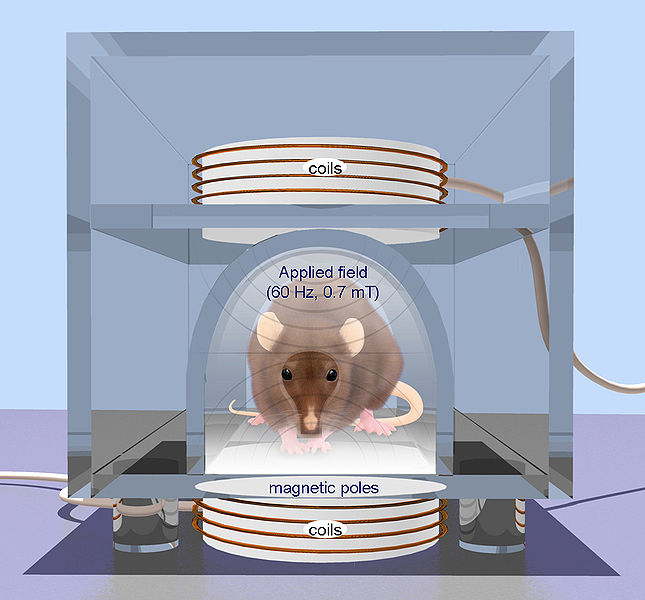Brain Stimulation for Treatment-Resistant Depression
There are many methods of stimulating the brain directly, ranging from the very invasive to the non-invasive. Below we discuss deep brain stimulation, frontal lobe and vagal nerve stimulation, repeated transcranial magnetic stimulation, electroconvulstive therapy (in particular the new right unilateral ultra-brief pulse method), and low level magnetic fields.

- Repetitive transcranial magnetic stimulation (rTMS) is a technique for noninvasive stimulation of the adult brain. Stimulation is produced by generating a brief, high-intensity magnetic field by passing a brief electric current through a magnetic coil. Compared with the growing number of clinical trial with rTMS, there are surprisingly few animal studies on its basic mechanisms of action, constraining the ability to perform hypothesis-driven clinical studies.
This is an Open Access image distributed under the terms of the Creative Commons Attribution License (http://creativecommons.org/licenses/by/2.0), which permits unrestricted use, distribution, and reproduction in any medium, provided the original work is properly cited. From: Arias-Carrión International Archives of Medicine 2008 1:2 doi:10.1186/1755-7682-1-2
Deep Brain Stimulation
At the American Psyciatric Association meeting in San Francisco in May 2009, Giacobbe et al. reported on the results of deep brain stimulation of an anterior-ventral part of the prefrontal cortex called the subgenual cingulate cortex in patients with refractory major depressive disorder. In deep brain stimulation, electrodes are inserted directly into the brain. Twenty-one patients received this treatment in an open study at sites in Canada at McGill University, the University of British Columbia, and the University of Toronto. This multi-center trial replicated results reported by Mayberg et al. (2005) with stimulation of what is also called Broadman’s area 25, or the part of the prefrontal cortex just under the anterior part of the corpus callosum (which carries fiber tracts between the left and right sides of the brain).
In the trial by Giacobbe et al., 13 of 21 patients achieved a 40% reduction in depressive symptoms, and an additional 4 out of the 21 had a partial response. At the last follow-up visit, two subjects had achieved full remission. The authors caution that verification of these findings in a placebo- or sham-controlled design (in which a procedure without real medical effects is performed for some period of time) is required before the effectiveness of deep brain stimulation in this area can be adequately assessed. While the 40% improvement rates are substantial in highly treatment-resistant patients, the finding that only two subjects achieved remission at the last follow-up demonstrates the relatively low rate of excellent or complete response with this highly invasive treatment intervention.
Less Invasive Approaches: Frontal Lobe and Vagal Nerve Stimulation
A variety of less invasive strategies in which the brain is not penetrated deserve futher study. As we have reviewed in previous BNNs, other forms of brain stimulation that are less invasive are currently being studied, including bilateral stimulation of the frontal lobes with subdural electrodes (which do not penetrate the brain substance), and vagal nerve stimulation (VNS), which requires an operation for the insertion of a stimulator in the chest wall and electrodes onto the left vagus nerve in the neck. VNS is FDA-approved for the treatment of both seizures and depression that have resisted other treatments.
Non-Invasive Approaches to Neurostimulation: rTMS
Repeated transcranial magnetic stimulation (rTMS) is also FDA-approved for treatment-resistant depression. It involves placing a magnet with a rapidly alternating magnetic field over the left prefrontal cortex while a person is awake. RTMS over the motor cortex produces movement in the hands or feet, but over the prefrontal area produces no motor effects.
Meta-analyses of a large series of relatively small placebo-controlled studies continue to indicate the efficacy of active rTMS compared with sham stimulation procedures, and a multi-center trial led to FDA approval of one type of rTMS apparatus, which is now increasingly becoming available to the public. A new NIMH replication study has just been published by Mark George et al. in the Archives of General Psychiatry and is described in the last BNN. In contrast to electroconvulsive therapy (ECT), rTMS does not require anesthesia or the induction of a seizure to be effective.
Right Unilateral Ultrabrief Pulse Electroconvulsive Therapy
If one is contemplating the use of electroconvulsive therapy (ECT), it may be prudent to discuss using the newly studied method using right unilateral ultra-brief pulse stimulation. Sackheim and colleagues reported in the journal Brain Stimulation in 2008 that this type of unilateral ECT was associated with degrees of improvement equivalent to traditional bilateral electrode placements, but was associated with substantially reduced impairments in autobiographical memory. Thus, if one is considering ECT for the treatment of acute unipolar or bipolar depression, current data suggest the likely better tolerability of the ultra-brief pulse right unilateral parameters compared with bilateral stimulation or even unilateral stimulation with a wider pulse width that may be associated with more memory loss.
Low Level Magnetic Fields (LLMF)
Researchers at McLean Hospital in Boston have reported antidepressant effects of rapid pulse sequences of the low level magnetic fields of a magnetic resonance imaging (MRI) machine. This is the same machine widely used to image the brain, but a different pulse sequence is utilized. This strategy deserves further study because of its lack of invasiveness compared to some other types of brain stimulation.
Comments
Leave a Reply

